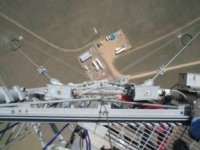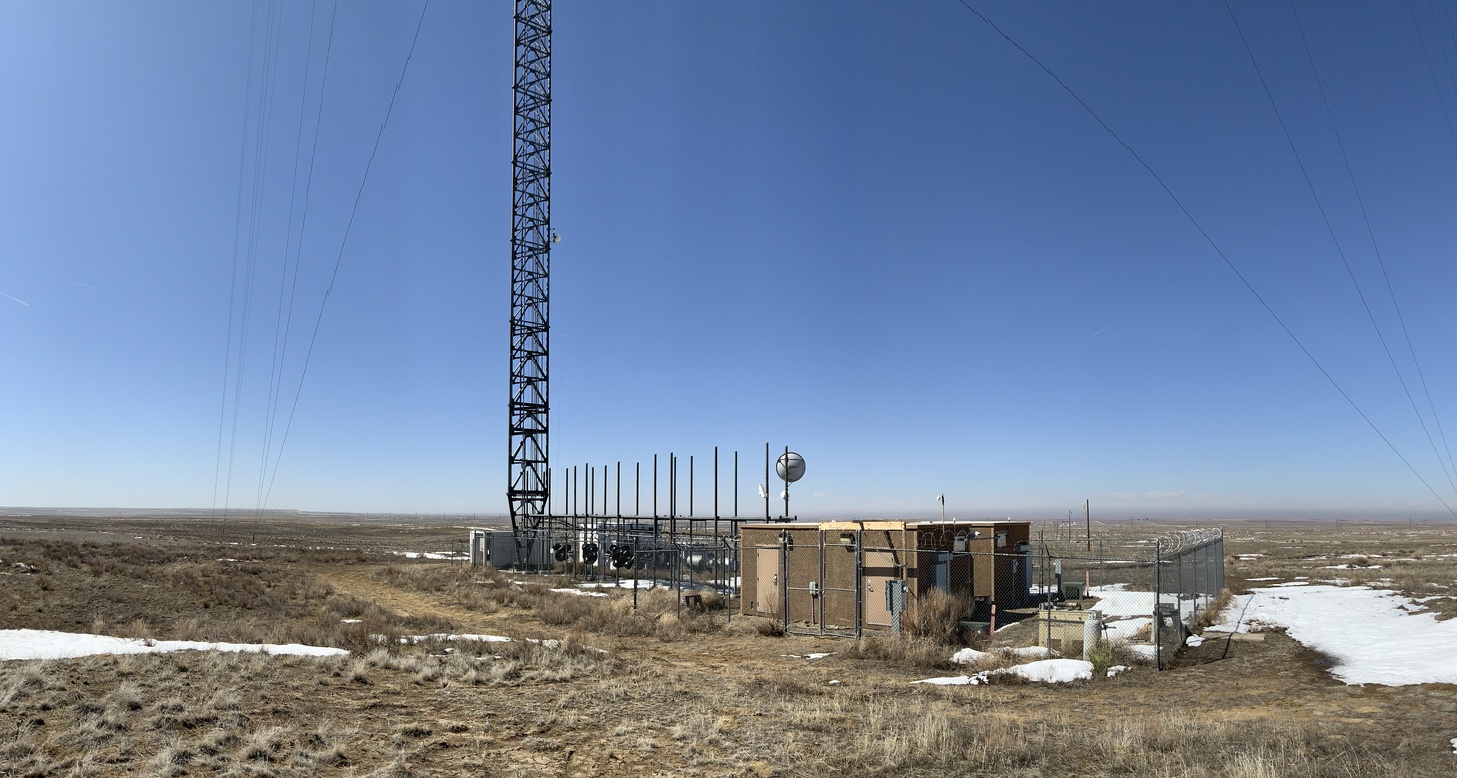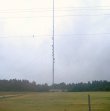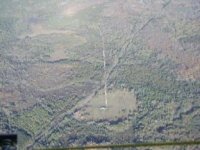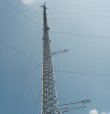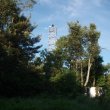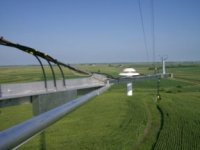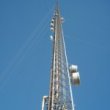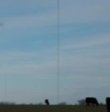In-Situ Measurement Program
The Carbon Cycle-Greenhouse Gases group conducts research to understand the global carbon cycle and its effects on climate. Measurements are made to determine baseline levels, trends and causes of variability of several atmospheric gases (carbon dioxide, methane and carbon monoxide), that have the potential to affect global climate. To obtain detailed understanding of the short term as well as long term variations of the greenhouse gases, measurements are made from a network of on-site (in-situ) locations.
NOAA Baseline Observatories
NOAA/GML operates staffed atmospheric baseline observatories from which numerous in situ and remote atmospheric and solar measurements are conducted. These observatories were established in order to provide sampling of the most remote air on the planet so that the true “background atmosphere” could be monitored. GML measures greenhouse gases at four of the Observatories: Barrow, Alaska; Mauna Loa, Hawaii; American Samoa; and South Pole, Antarctica. GML first began measurements of CO2 at the observatories in 1973, and added CH4 and CO measurements in the 1980's. Continuous in-situ measurements of these gases provides great detail in their long term trends, seasonal and short-term variations, and diurnal cycles.
Tall Towers
The NOAA GML tall tower network provides regionally representative measurements of carbon dioxide (CO2) and related gases in the continental boundary layer. Recently we have also begun sampling gases that are relevant for air quality studies. We collect meteorological data that can be used to study boundary layer dynamics. The tall tower sites are part of the North American Carbon Program and are a primary data source for GML's Carbon Tracker CO2 data assimilation system.
The Global Monitoring Laboratory (GML) began making measurements from tall towers in the 1990s in order to extend long-term carbon-cycle gas monitoring to continental areas. Existing television, radio and cell phone towers are utilized as sampling platforms for in-situ and flask sampling of CO2 and other atmospheric trace gases, including carbon monoxide (CO). Carbon dioxide is the principal carbon greenhouse gas, and measurements of its abundance are sensitive to upwind fluxes, including fossil fuel emissions and uptake and release by vegetation and soils. Carbon monoxide is an indicator of combustion, and elevated levels can result from urban or industrial emissions or from biomass burning. CO data contribute to the interpretation of CO2 measurements by helping to identify and quantify pollution episodes. Plans call for the addition of six more towers distributed throughout the continental US over the next several years.
Additional In-Situ Sites
There are a few extra sites making in-situ measurements of greenhouse gases. These sites have lower intake heights (<50m) than the tall tower program, and are not part of the NOAA Baseline Observatory system.
Sites
Argyle, Maine
45.03 °N, 68.68 °W
- Affiliation: Unicel
- Elevation: 50 masl
- Intake Heights: 12, 30, 107 meters above ground
- Gases Measured: CO2, CO
- Available datasets | Data visualization
The AMT site uses a 107m Unicel cellular telephone transmitter tower near Argyle, Maine. This site was instrumented in September 2003 in time for the CO2 Airborne Budget and Regional Airborne (COBRA) - Maine Study, which occurred during summer 2004.
Partners:- University of Maine (John Lee),
- USDA Forest Service Northern Research Station (David Hollinger),
- Harvard Univerisity (Steve Wofsy, Bill Munger)
Boulder Atmospheric Observatory (BAO) - Discontinued
Erie, Colorado
40.05 °N, 105.01 °W
- Affiliation: NOAA
- Elevation: 1584 masl
- Intake Heights: 22, 100, 300 meters above ground
- Gases Measured: CO2, CO
- Available datasets | Data visualization
The Boulder Atmospheric Observatory (BAO) tower has been operated by the Physical Sciences Laboratory (PSL) since the 1970s and serves as a unique facility for monitoring the Earth's atmospheric boundary layer. Instrumentation for monitoring CO2 and CO was installed in April 2007. Because of its proximity to the Denver metropolitan area, measurements from the BAO tower will provide detailed information about urban and industrial sources of CO2.
Barrow, Alaska
71.323 °N, 156.6114 °W
- Affiliation: NOAA Observatory
- Elevation: 11 masl
- Intake Heights: 16.46 meters above ground
- Gases Measured: CO2, CH4, CO
- Available datasets | Data visualization
Barrow is the northern most point in the United States. It was the first NOAA/GML site to begin continuous in-situ measurements of CO2, starting in July 1973. CH4 measurements began in January 1986, and CO measurements in September 1991.
Leader, Colorado
39.02 °N, 103.97 °W
- Affiliation: NOAA
- Elevation: 1480 masl
- Intake Heights: 30, 100, 486 meters above ground
- Gases Measured: CO2, CH4, CO
- Available datasets | Data visualization
The Colorado Atmospheric Observatory (CAO) site was chosen to sample continental background air east of the Rocky Mountains. CAO is located near Leader, Colorado 40 miles due east from the Denver International Airport. After decommissioning the BAO site in Erie, Colorado, a site was desired that was further from the influences of Denver/Metro area and perturbations due to the front range.
Cherskii, Russia (CHS) - Discontinued
Cherskii, Russia
68.5135 °N, 161.5313 °E
- Affiliation:
- Elevation: 30 masl
- Intake Heights: 2.6, 16.2, 34.4 meters above ground
- Gases Measured: CH4
- Available datasets | Data visualization
WITN Tower (ITN) - Discontinued
Grifton, North Carolina
35.53 °N, 77.38 °W
- Affiliation: WITN-TV
- Elevation: 9 masl
- Intake Heights: 51, 123, 496 meters above ground
- Gases Measured: CO2
- Available datasets | Data visualization
The WITN-TV transmitter tower was the first tall tower measurement site in the GML network. Measurements began in June, 1992, with continuous monitoring of CO2 and 222Rn mixing ratios, wind speed and direction, temperature, and relative humidity at 51, 123 and 496 m above the ground. Unfortunately, our work at the WITN tower site had to be discontinued in June 1999 because the tower owner need the space that was occupied by our equipment in order to install an HDTV transmitter, as mandated by Congress. We thank American Family Broadcasting for hosting our measurements for 7 years.
Park Falls, Wisconsin
45.9451 °N, 90.2732 °W
- Affiliation: WLEF-TV
- Elevation: 472 masl
- Intake Heights: 11, 30, 76, 122, 244, 396 meters above ground
- Gases Measured: CO2, CO
- Available datasets | Data visualization
The 447-m tall WLEF-TV transmitter tower in northern Wisconsin became the second site for the tall tower program in October, 1994. This tower is owned by the State of Wisconsin Educational Communications Board. A large program has evolved around our measurements at the WLEF tower, involving a number of university and federal research institutions. The goals are to assess the carbon budget of the forests in the region (the Chequamegon National Forest), and to examine the influence of forest/atmosphere CO2 exchange on CO2 mixing ratios within and above the atmospheric boundary layer over the continent. This program is known as the Chequamegon Ecosystem-Atmosphere Study (ChEAS). The ChEAS project is also a part of the AmeriFlux program. Scientists from Caltech and NASA JPL began making total column CO2 measurements at the base of the WLEF tower in 2004 by FTIR spectroscopy. These measurements are part of the validation effort for NASA's Orbiting Carbon Observatory to be launched in 2008.
Partners:- Penn State University (Ken Davis),
- University of Wisconsin (Ankur Desai),
- USDA Forest Service Northern Research Station (Ron Teclaw and Dan Baumann)
Mount Bachelor, Oregon
43.9775 °N, 121.6861 °W
- Affiliation: University of Washington
- Elevation: 2731 masl
- Intake Heights: 11 meters above ground
- Gases Measured: CO2, CO
- Available datasets | Data visualization
The Mt. Bachelor Observatory is located at the Mt. Bachelor Ski Area and is run with the cooperation of Mt. Bachelor, Inc. An isolated volcanic peak with a summit at 2.7 km asl, Mt. Bachelor receives mostly free tropospheric air and sometimes stratospheric air which has been relatively undisturbed during transport from Asia.
Partners:- University of Washington (Dan Jaffe),
Mauna Loa, Hawaii
19.5362 °N, 155.5763 °W
- Affiliation: NOAA Observatory
- Elevation: 3397 masl
- Intake Heights: 40 meters above ground
- Gases Measured: CO2, CH4, CO
- Available datasets | Data visualization
Mauna Loa Observatory (MLO) is a premier atmospheric research facility that has been continuously monitoring and collecting data related to atmospheric change since the 1950's. CO2 measurements began in 1957 by Dave Keeling of Scripps Institution of Oceanography. NOAA/GML began continuous in-situ CO2 measurements in 1974, then followed with CH4 in 1987 and CO measurements in 1992.
Beech Island, South Carolina
33.406 °N, 81.833 °W
- Affiliation: Augusta Tower LLC
- Elevation: 115 masl
- Intake Heights: 30, 61, 305 meters above ground
- Gases Measured: CO2, CO
- Available datasets | Data visualization
NOAA/GML began continuous measurements of CO2 and CO at the "South Carolina Tower" in August 2008 as part of a partnership with the Department of Energy Office of Science to expand carbon cycle research at the Savannah River Site. The SCT site takes advantage of a pre-existing comprehensive meteorological network in the region that is operated by the Savannah River National Laboratory. The SRNL network includes 3-dimensional sonic anemometers and fast response CO2 and H2O sensors at each of the sampling heights on the tower that are now also used for the NOAA CO2 and CO measurements. This location samples the southeastern US within a mixed use agricultural, residential, and industrial zone.
Partners:- Savannah River National Laboratory (Matt Parker),
- University of Georgia (Professor Monique LeClerc)
Tutuila Island, American Samoa
14.2474 °S, 170.5644 °W
- Affiliation: NOAA Observatory
- Elevation: 42 masl
- Intake Heights: 18 meters above ground
- Gases Measured: CO2
- Available datasets | Data visualization
The American Samoa Observatory (SMO) is located in the middle of the South Pacific, about midway between Hawaii and New Zealand. It is characterized by year-round warmth and humidity, lush green mountains, and strong Samoan culture. The observatory is situated on the northeastern tip of Tutuila Island, American Samoa, at Cape Matatula. NOAA/GML began continuous in-situ CO2 measurements at SMO in 1976.
Shenandoah National Park, Virginia
38.617 °N, 78.35 °W
- Affiliation: University of Virginia
- Elevation: 1008 masl
- Intake Heights: 5, 10, 17 meters above ground
- Gases Measured: CO2, CO
- Available datasets | Data visualization
South Pole, Antarctica
89.98 °S, 24.8 °W
- Affiliation: NOAA Observatory
- Elevation: 2810 masl
- Intake Heights: 11 meters above ground
- Gases Measured: CO2
- Available datasets | Data visualization
The South Pole Observatory (SPO) is located at the geographic South Pole on the Antarctic plateau at an elevation of 2837 m above sea level. The South Pole Observatory was established in 1957 as part of the International Geophysical Year. The National Science Foundation provides the infrastructure for the GML scientific operations including a state of the art science building named the Atmospheric Research Observatory (ARO). NOAA/GML began continuous in-situ CO2 measurements at SPO in 1975.
West Branch, Iowa
41.725 °N, 91.353 °W
- Affiliation: KWKB-TV
- Elevation: 242 masl
- Intake Heights: 31, 99, 379 meters above ground
- Gases Measured: CO2, CO
- Available datasets | Data visualization
Instrumentation was installed on the KWKB-TV tower in July 2007. The WBI site samples agricultural ecosystems in the corn belt. Summertime CO2 levels in this region are among the lowest in North America due to strong uptake by corn and other crops. We expect to see interannual variability in the CO2 seasonal cycle that is related to crop yields, which are carefully tracked. For example, 2007 is expected to be a record corn crop, as demand has increased for production of biofuels.
Partners:- University of Iowa (Charles Stanier)
Walnut Grove, California
38.265 °N, 121.4911 °W
- Affiliation: Richland
- Elevation: 0 masl
- Intake Heights: 30, 91, 483 meters above ground
- Gases Measured: CO2, CH4, CO
- Available datasets | Data visualization
The WGC tower was instrumented in September 2007 through a collaborative effort with the Deparment of Energy's Lawrence Berkeley National Laboratory. The California Energy Commission is funding the project through its Public Interest Energy Research Program. The WGC site is equipped to provide continuous measurements of CO2, CO and CH4. WGC is the first tall tower site with continuous CH4 measurements. WGC is instrumented with automated flask sampling systems that provide daily measurements of a suite of greenhouse gases, carbon isotopes, halocarbons and other compounds.
Partners:- DOE Environmental Energy Technologies Division at Lawrence Berkeley National Laboratory (Marc Fischer)
- Affiliation: KWKT-TV
- Elevation: 251 masl
- Intake Heights: 30, 122, 457 meters above ground
- Gases Measured: CO2, CO
- Available datasets | Data visualization
Moody, Texas
31.32 °N, 97.33 °W
Sensors were installed on the KWKT-TV transmitter tower in February 2001. In May 2006, this site became the first to use our newly redesigned instrumentation suite. The upgrades were made in time for the Texas Air Quality Study 2006 . We also carried out a demonstration study during 2006 where an O3 sensor was mounted at our highest sampling level (457 m above ground level). The O3 data showed clear evidence of nighttime transport of ozone in the nocturnal jet at the top of the planetary boundary layer. This site periodically samples air that has passed over the Dallas - Fort Worth and Houston metropolitan areas. At other times, the site samples relatively clean air from the Gulf of America (formerly Gulf of Mexico). Summertime weather patterns are dominated by a monsoonal circulation over the Gulf. WKT thus provides a measurement of the initial CO2 concentration for air passing over the continent from the south. As air moves northward, the CO2 concentration is modified by the action of sources (fossil fuel combustion, plant respiration, biomass burning, cement production) and sinks (photosynthesis).
Partners:- Blackland Research and Extension Center-Texas Agricultural Experiment Station (Onyango Okello)



